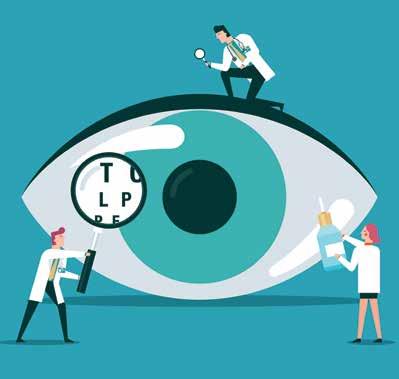
3 minute read
Don’t Look Away: Pay
Don’t Look Away
PAYING ATTENTION TO EYE HEALTH
By Dylan Roche
You might say that too many people in the United States are turning a blind eye to their eye health. An estimated 142 million Americans over age 40 have some kind of vision problem, according to the National Academies of Sciences, Engineering and Medicine—and most of those problems can be fixed if they’re treated early.
The issue? Most people underestimate or disregard the importance of regular eye examinations. It’s one of the reasons the American Optometric Association (AOA) is a sponsor and proponent of Save Your Vision Month, observed every March by doctors of optometry across the country.
Because when more people prioritize their eye health, they avoid long-term vision problems that can hinder everything from professional productivity to social engagement. And in children, vision problems can affect their education and development.
Annual eye exams are about more than catching blurring vision—you want to stay abreast of serious developing eye problems and detect them early. Conditions like glaucoma are often detected only once it’s too late to reverse them.
According to the Mayo Clinic, adults with no vision problems and no family history should have their eyes checked every five to 10 years in their 20s and 30s, every two to four years from age 40 to 54, every year to every three years from age 55 to 64, and every year or every other year after age 65.
But aside from routine screenings, there are important signs to watch out for that indicate you should have your eyes checked:
• If you notice any changes in your vision, such as difficulty seeing objects at a distance where they were once easy to see clearly • You suffer eye strain or headaches, especially after staring at a computer screen for an extended period of time • You have to squint to read, or you have to hold reading material far away • You have to close one eye to read something clearly • You see spots or flashes of light • You get dizzy after watching something that’s moving • Your eyes are red and dry • You should also get your eyes checked more frequently if you have glaucoma or diabetes in your family history, or if you are taking medications that have side effects pertaining to your eyes/vision.
Want to take better care of your eyes? Here are some healthy practices you can observe to maintain a powerful set of peepers.
• Avoid staring at screens for too long. The AOA recommends using a 20/20/20 rule: Every 20 minutes, look away from your screen and stare at something 20 feet away for at least 20 seconds.
• Eat a healthy diet with a variety of nutrients for eye health. Colorful fruits and vegetables like leafy greens, berries, beets, sweet potatoes, and (of course) carrots are all great choices. Fish is another great addition to your diet because it’s a good source of omega-3 fatty acids. • When you go outside in the sun, be sure to bring your shades. Opt for sunglasses that offer UV protection, as these rays can damage your eyes. Along the same lines, wear protective eye goggles when you’re playing sports or engaging in high-risk activities like construction. • Clean your contact lenses with high-quality contact solution. Never use your saliva to clean contacts—saliva contains bacteria that is harmful to your eyes. • Get plenty of exercise. Physical activity helps stave off conditions like high blood pressure and diabetes, which can lead to eye diseases. • Take care with your makeup. Old or dirty eye makeup can cause big problems—replace mascara and liquid eyeliners every three months, and replace eyeshadow and pencil liners at least once a year.










